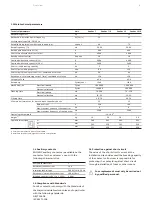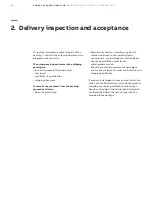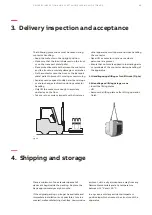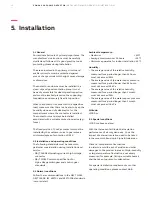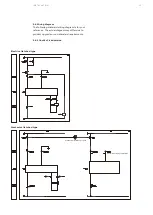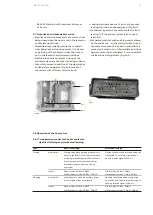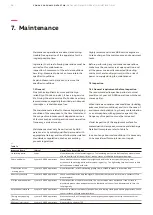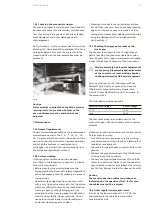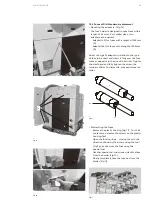
I N S T A L L A T I O N
21
5.7 Assembly and connections
5.7.1 Fixed version
Before carrying out any installation operations
:
•
Test all the power terminals to check that they
are not supplied with voltage. Only use high
voltage testing equipment approved for checking
the voltage on the power terminals. Do not
attempt to measure the high voltage (above
600 V) with a volt-ohm/meter
•
Check all the control and secondary circuit
terminals with a voltmeter to ensure that all the
control and secondary input voltage sources have
been turned off
•
After de-energizing but before proceeding with
any work on the apparatus, confirm that power
terminals have been grounded and are in safe
conditions
•
Carry out all the operations for turning off the
voltage and grounding according to the
established safety procedures
General inspections
•
Clean the insulation surface with a rough dry cloth
•
Check that the contact surfaces of the connections
are flat, and are free of any burrs, traces of
oxidation or deformation caused by drilling or
impacts received
•
Select the cross-section of the conductors
according to the service current and the short-
circuit current of the installation
•
Prepare special support insulators near the
terminals of the contactor, sized according to
the electrodynamic forces caused by the short-
circuit current of the installation and avoid
stressing the connections laterally
ConVac installation and connection of the
primary circuit
•
Fixed conductors could be installed directly on
the support frame, according to the overall
dimensions in 5.5.1
•
put the connections in contact with the contactor
terminals, taking care to avoid mechanical stresses
produced, for example, by the conductor busbars
on the terminals themselves
•
Interpose a spring and a flat washer between the
head of the bolt and the connection. The use of
bolts according to DIN class 8.8 Standards is
recommended, also referring to what is indicated
in the table
•
In the case of cable connections, strictly follow
the manufacturer’s instructions for making the
terminals
•
Grounding of fixed ConVac is realized by
grounding bolt, accompanied by a grounding
sign as Fig 5a shows. An area of about 30 mm
around the grounding bolt should be kept clean,
reapply Vaseline lubricant to cover the joint after
installation. Use cables with a suitable cross-
section according to related standards
Connection of the auxiliary circuits
•
The cables to be used for connection of the
auxiliary circuits must no less than the cable
used inside the contactor, and be insulated for
2 kV/1 min test
•
Please refer to 5.6.1 for the wiring of auxiliary
circuit, make sure the cables are reliably
connected to the contactor
•
Outside, the wires must run through metallic
pipes or ducts suitably grounded
5.7.2
Withdrawable version
•
The withdrawable contactors are used in the
UniGear ZS1 or other switchgear with the same
dimension
•
Confirm that the contact fingers are clean, and
no deformation due to shipping or crash
•
The auxiliary circuit connections of withdrawable
contactor are derived via the plug. The wiring
diagram could refer to chapter 5.6.2
•
The cables to be used for connection of the
auxiliary circuits must no less than the cable used
inside the contactor, and be tested for 2 kV/ 1 min
•
three current-limiting fuses (prepared by
customers) with high breaking capacity connected
in series with the contactor, with dimensions
according to
- DIN 43625 Standard with maximum length e
=442 mm
—
Fig 5c
- BS 2692 Standard with maximum distance L
=454 mm
5.7.3 Interlock of withdrawable version
•
Electrical lock which prevents the contactor from
being closed when the truck is not in the racked-in
and isolated positions
•
Mechanical lock which prevents the contactor
from being racked-in and out when it is closed
and closing of the contactor when the truck is
not in the racked-in and isolated positions
•
Electrical lock which prevents closing of the
contactor when any one fuse is missing or blown
•
Lock which prevents insertion of the plug-socket
and therefore apparatus (Fig 5c,interlock of
contactors with different rated current)
Type
Closing
Opening
Description
Inputs
Description
Inputs
5.8 Operation of the Contactors
5.8.1 Two operation modes for ConVac contactor:
electrical latching and mechanical latching
Electrical latching
Closing takes place by supplying auxiliary
power to the feeder. The minimum duration
of closing impulse signal is 300 ms (a short
impulse signal will make the contactor
immediately opens after the closing
operation)
Fixed version
:
XDB1:1 - XDB1:3
Withdrawable version
:
XDB:31 - XDB:30
opening occurs when the auxiliary power
is interrupted either intentionally
Fixed version: XDB1:1 - XDB1:3
Withdrawable version: XDB:31 - XDB:30
Mechanical latching
Closing takes place when the opening coil
is Supplied. The minimum duration of
closing impulse signal is 300 ms
Fixed version
:
XDB1:1 - XDB1:3
Withdrawable version
:
XDB:4 - XDB:14
Opening takes place when the opening
coil is supplied. The minimum duration of
opening impulse signal is 300 ms
Fixed version: XDB3:1 - XDB3:3
Withdrawable version: XDB:31 - XDB:30
—
Fig 5b
5b-2
5b-1
5b-3
•
Locking electromagnet on the truck to prevent
racking-in/out when dis-energised.
(
Fig 5b-1
)
•
Mechanical lock which prevents contactor from
racking-in if the enclosure door is not closed
(
Fig 5b-2
)
•
Mechanical interlock with earthing switch placed
on the enclosure
:
with earthing switch closed
the contactor cannot be racked-in and with the
contactor racked-in or in intermediate positions
between racked-in and isolated, it is not possible
to close the earthing switch
(
Fig 5b-3
)
Summary of Contents for ConVac
Page 2: ......
Page 35: ...安装 21 ...



